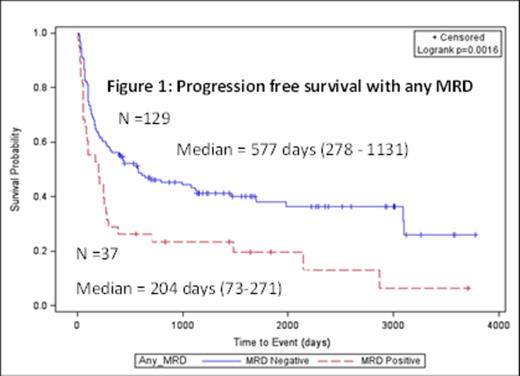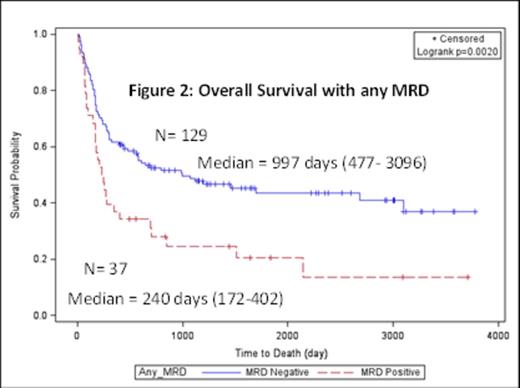Abstract
Introduction: Persistent AML is a known risk factor for poor outcomes after allo-HCT. The impact of MRD in patients who achieve complete remission (CR) or CR with incomplete count recovery (CRi) has been less well studied.
Methods: We retrospectively reviewed the records of AML patients who underwent allo-HCT in morphological remission (<5% myeloblasts and normal marrow cellularity) with or without blood count recovery between January, 2000 and January, 2014. Data was collected for variables known to impact the prognosis of AML patients (Table 1). MRD was defined as evidence of abnormalities associated with AML by either flow cytometry, cytogenetics or Fluorescence in situ hybridization (FISH). The impact of MRD identified at the time of allo-HCT on cumulative incidence of relapse (CIR), progression free survival (PFS), and overall survival (OS) was assessed in MRD+ and MRD- patients.
Results: A total of 166 eligible patients were identified. The median follow-up among living patients is 46 months (range, 13-103).Thirty seven (22%) patients had evidence of MRD (13 by flow cytometry only, 17 by cytogenetics/FISH only and 7 by both). MRD was more common in patients with poor risk karyotype at diagnosis and CRi at the time of allo-HCT (Table 1). PFS (P= 0.0016), OS (P=0.002), and CIR (P=0.02) were all significantly worse in MRD+ patients (Figures 1& 2). In univariate analysis, MRD+ patients, assessed by flow cytometry had worse PFS (P=0.0216) and OS (P=0.0314) compared to MRD- patients. Similarly patients with evidence of MRD+ by cytogenetics/FISH had worse PFS (P=0.007) and OS (P=0.0031). In a multivariate cox proportional hazards model 1) any MRD positivity prior to allo-HCT, 2) poor-risk karyotype at diagnosis, and 3) CRi at allo-HCT independently predicted significantly poor PFS and OS. Only poor-risk karyotype was associated with a significant increase in CIR, while MRD positivity showed a trend towards higher CIR.
Conclusion: MRD positivity prior to HCT by either flow cytometry or by cytogenetics/FISH independently predicts adverse AML outcomes.
Comparison of pre-transplant variables
| Covariate . | Label . | MRD + (N=37) . | MRD - (N=129) . | P-Value . |
|---|---|---|---|---|
| Age(years) | < 40 | 8 (21%) | 20 (16%) | 0.708 |
| 40 - 59 | 20 (53%) | 69 (54%) | ||
| ≥ 60 | 10 (26%) | 39 (30%) | ||
| Karyotype risk | Favorable/ Intermediate | 19 (53%) | 95 (74%) | 0.011 |
| Poor | 18 (47%) | 33 (26%) | ||
| Timing of Allo-HCT | 1st remission (CR1) | 28 (74%) | 97 (76%) | 0.792 |
| > CR1 | 10 (26%) | 31 (24%) | ||
| Allo-HCT after1st relapse(>CR1): duration of CR1 | > 12 mo | 31 (82%) | 113 (88%) | 0.285 |
| ≤ 12 mo | 7 (18%) | 15 (12%) | ||
| Secondary AML | No | 23 (60%) | 78 (61%) | 0.964 |
| Yes | 15 (40%) | 50 (39%) | ||
| Complete remission vs CRi | CR | 28 (74%) | 110 (86%) | 0.077 |
| CRi | 10 (26%) | 18 (14%) | ||
| Conditioning Regimen | Ablative | 24 (63%) | 72 (56%) | 0.449 |
| Other | 14 (37%) | 56 (44%) | ||
| Donor Type | Matched sibling donor | 12 (32%) | 42 (33%) | 0.887 |
| Other | 26 (68%) | 86 (67%) | ||
| Female donor: male recipient (FDMR) | Other | 28 (80%) | 91 (78%) | 0.844 |
| FDMR | 7 (20%) | 25 (22%) |
| Covariate . | Label . | MRD + (N=37) . | MRD - (N=129) . | P-Value . |
|---|---|---|---|---|
| Age(years) | < 40 | 8 (21%) | 20 (16%) | 0.708 |
| 40 - 59 | 20 (53%) | 69 (54%) | ||
| ≥ 60 | 10 (26%) | 39 (30%) | ||
| Karyotype risk | Favorable/ Intermediate | 19 (53%) | 95 (74%) | 0.011 |
| Poor | 18 (47%) | 33 (26%) | ||
| Timing of Allo-HCT | 1st remission (CR1) | 28 (74%) | 97 (76%) | 0.792 |
| > CR1 | 10 (26%) | 31 (24%) | ||
| Allo-HCT after1st relapse(>CR1): duration of CR1 | > 12 mo | 31 (82%) | 113 (88%) | 0.285 |
| ≤ 12 mo | 7 (18%) | 15 (12%) | ||
| Secondary AML | No | 23 (60%) | 78 (61%) | 0.964 |
| Yes | 15 (40%) | 50 (39%) | ||
| Complete remission vs CRi | CR | 28 (74%) | 110 (86%) | 0.077 |
| CRi | 10 (26%) | 18 (14%) | ||
| Conditioning Regimen | Ablative | 24 (63%) | 72 (56%) | 0.449 |
| Other | 14 (37%) | 56 (44%) | ||
| Donor Type | Matched sibling donor | 12 (32%) | 42 (33%) | 0.887 |
| Other | 26 (68%) | 86 (67%) | ||
| Female donor: male recipient (FDMR) | Other | 28 (80%) | 91 (78%) | 0.844 |
| FDMR | 7 (20%) | 25 (22%) |
No relevant conflicts of interest to declare.
Author notes
Asterisk with author names denotes non-ASH members.



This feature is available to Subscribers Only
Sign In or Create an Account Close Modal